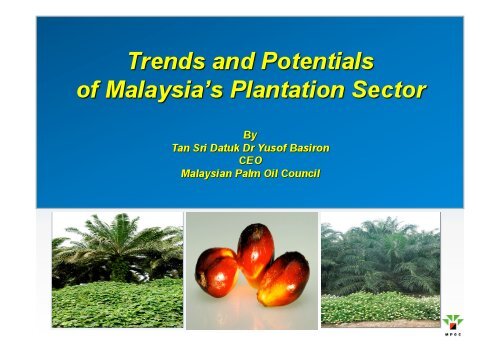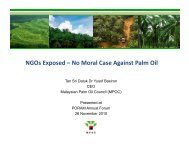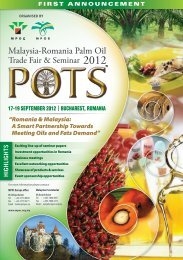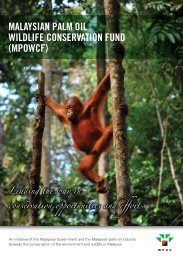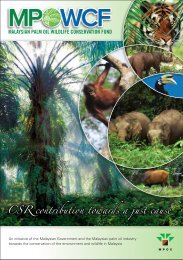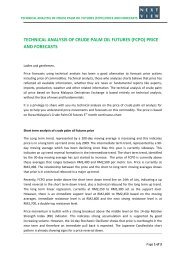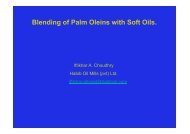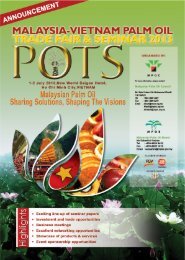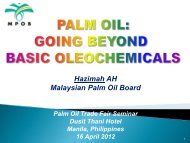Trends & Potentials of Malaysia's Plantation Sector - MPOC
Trends & Potentials of Malaysia's Plantation Sector - MPOC
Trends & Potentials of Malaysia's Plantation Sector - MPOC
Create successful ePaper yourself
Turn your PDF publications into a flip-book with our unique Google optimized e-Paper software.
Palm oil industry is fairly recession pro<strong>of</strong>.<br />
Adequate supply rationalisation CAPACITY. Opportunities to<br />
sustain prices at remunerative levels.<br />
Strong demand trends favouring palm oil for future sustained<br />
pr<strong>of</strong>its.<br />
Oil palm is dominating land allocation through superior economic<br />
viability ... It impacts other commodities.<br />
New forms <strong>of</strong> trade barriers using environment and global<br />
warming issues may erode palm oil’s competitiveness.
1. Design Biodiesel Policies<br />
2. Stock Management – Replanting Strategy<br />
3. Capitalise on Net Excess Supply Position with Indonesia<br />
4. Increasing Demand & Promotion<br />
5. Tackling Issues on Environment<br />
6. Branding and Brand Support
Discount over soybean oil hit<br />
above US$400 during 2008
Volume<br />
(‘Million MT)<br />
Value<br />
(‘RM Million)
Percentage
Margin (as % <strong>of</strong> Price)<br />
Cost<br />
(RM)<br />
15% 20% 25% 30% 35% 40% 45% 50%<br />
1,000 1,176 1,250 1,333 1,429 1,538 1,667 1,818 2,000<br />
1,100 1,294 1,375 1,467 1,571 1,692 1,833 2,000 2,200<br />
1,200 1,412 1,500 1,600 1,714 1,846 2,000 2,182 2,400<br />
1,300 1,529 1,625 1,733 1,857 2,000 2,167 2,364 2,600<br />
1,400 1,647 1,750 1,867 2,000 2,154 2,333 2,545 2,800<br />
1,500 1,765 1,875 2,000 2,143 2,308 2,500 2,727 3,000<br />
1,600 1,882 2,000 2,133 2,286 2,462 2,667 2,909 3,200<br />
1,700 2,000 2,125 2,267 2,429 2,615 2,833 3,091 3,400
Production<br />
Cost (RM)<br />
Average<br />
Price (RM)<br />
Margin<br />
(RM)<br />
Margin<br />
(%)<br />
Cost as %<br />
Price<br />
2004 600 1,610 1,010 63% 37%<br />
2005 800 1,394 594 43% 57%<br />
2006 900 1,511 611 40% 60%<br />
2007 1,000 2,531 1,531 60% 40%<br />
2008 1,200 2,778 1,578 57% 43%<br />
*per tonne basis
Total area under oil palms = 4.48 mil ha or 13.1% <strong>of</strong> total land<br />
area or 67 % <strong>of</strong> agricultural area. Future trend >> limited land<br />
for agriculture.<br />
41% <strong>of</strong> world’s palm oil production and 47% <strong>of</strong> world’s exports.<br />
Malaysia is No 2 in production and No 1 in exports.<br />
11.1% <strong>of</strong> world’s total oils and fats production and 27% <strong>of</strong><br />
world’s oils and fats exports.<br />
Provides direct employment to 570,000 people, excluding other<br />
multiplying effects and spin-<strong>of</strong>f activities.
Oil palm occupies 4.48 million ha or less than 2% <strong>of</strong> the total<br />
area (233 mil) under global oilseed cultivation or 0.09% <strong>of</strong> world<br />
total agriculture areas.<br />
NGOs claim palm oil cause <strong>of</strong> deforestation and global warming<br />
BUT What about 99.91 % <strong>of</strong> agricultural land in other countries<br />
that was formerly mostly forest land?<br />
Significant foreign exchange earner: RM 65.2billion in 2009.<br />
Oil palm is the backbone <strong>of</strong> country’s development especially for<br />
rural development and political stability.<br />
Malaysian palm oil is consumed in over 150 countries worldwide.<br />
Latest trend in Friends <strong>of</strong> Earth (FoE) headlines:- “Palm oil<br />
<strong>Plantation</strong>s not helping anyone”. The NGOs must be getting<br />
desperate to issue such negative statements.
Million MT
Annual global production growth during 2003-08 was<br />
5.8% per annum.<br />
Palm oil had the highest growth at 11.1% per year during<br />
this period. Soybean and rapeseed growth rates were<br />
4.5% and 8.3% respectively.<br />
In 2008, average growth <strong>of</strong> all oils estimated at 4.1%, with<br />
palm oil at 11.2%, rapeseed at 5.9% while soybean<br />
dropped by 0.5%.
Million MT
Million MT
Future <strong>of</strong> palm oil is<br />
driven by growth in<br />
demand for food,<br />
oleochemicals and<br />
bio fuel due to<br />
population and<br />
economic growth<br />
The world population is projected to<br />
grow from 6 billion in 1999 to 9 billion by<br />
2043, an increase <strong>of</strong> 50 percent.
Very few countries are in a position <strong>of</strong> net excess to supply oils<br />
and fats to the world market. Most countries are net importers <strong>of</strong><br />
oils and fats, even when the biodiesel industry has not taken <strong>of</strong>f<br />
in a big way.<br />
This future will portray potential supply shortages, if bi<strong>of</strong>uel usage<br />
is factored in. Consumption will be affected if there’s global<br />
recession, but more than 80% vegetable oils end up in food, which<br />
is a basic need. Palm oil should be able to fill in the supply gap on<br />
its competitive pricing to shift demand from more expensive<br />
vegetable oils.<br />
This provides a unique scenario for the oils and fats suppliers and<br />
exporters, as they can expect the demand to be sustainable in the<br />
near future.
Most countries are net<br />
importers, including the<br />
US since 2006.<br />
Developed countries<br />
e.g in the EU with<br />
ambitious bio-diesel<br />
programmes & future<br />
targets are already<br />
major net importers <strong>of</strong><br />
oils and fats – even<br />
when the bio-diesel<br />
industry has not yet<br />
taken <strong>of</strong>f in a big way.<br />
This provides an<br />
optimistic scenario for<br />
oil and fats suppliers<br />
and exporters as they<br />
can expect prices to<br />
remain remunerative.<br />
('000 MT)<br />
50,000<br />
45,000<br />
40,000<br />
35,000<br />
30,000<br />
25,000<br />
20,000<br />
15,000<br />
10,000<br />
5,000<br />
0<br />
2000 2002 2004 2006 2008<br />
Other Bangladesh Pakistan India EU-27 China
45,000<br />
40,000<br />
Very few<br />
countries are in a<br />
position <strong>of</strong> nett<br />
excess to supply<br />
oils & fats to the<br />
world market<br />
('000 MT)<br />
35,000<br />
30,000<br />
25,000<br />
20,000<br />
15,000<br />
10,000<br />
5,000<br />
0<br />
2000 2002 2004 2006 2008<br />
Other Ukraine Brazil Argentina Indonesia Malaysia
50,000<br />
45,000<br />
40,000<br />
('000 MT)<br />
35,000<br />
30,000<br />
25,000<br />
20,000<br />
2000 2002 2004 2006 2008<br />
Net Export<br />
Net Import
Malaysia,<br />
Indonesia &<br />
Argentina –<br />
are major nett<br />
exporters <strong>of</strong><br />
oils and fats.<br />
China PR<br />
EU-27<br />
India<br />
North Africa<br />
Pakistan<br />
Iran<br />
Bangladesh<br />
Mexico<br />
Japan<br />
Turkey<br />
South Africa<br />
South Korea<br />
Russia<br />
Nigeria<br />
Taiwan<br />
Others<br />
Brazil <br />
Ukraine <br />
Canada <br />
Philippines <br />
Thailand <br />
Argentina <br />
Net<br />
Importers<br />
Net<br />
Exporters<br />
Indonesia <br />
Malaysia <br />
(x 1000<br />
tonnes)<br />
‐15,000 ‐10,000 ‐5,000 0 5,000 10,000 15,000 20,000 25,000 30,000 <br />
Source: Oil World
(f)<br />
(f)
Source: MPOB
Source: MPOB
The blend <strong>of</strong> palm oil, soybean oil and canola oil is marketed<br />
commercially in USA and Malaysia under the Smart Balance<br />
Brand<br />
The ideal benefit<br />
Increasing HDL-cholesterol<br />
Lowering LDL-cholesterol<br />
A positive synergy with up to 50% palm oil content
Palm Olein: Goodness in Every Drop<br />
Contains heart-healthy monounsaturated oleic acid<br />
High in Vitamin E tocotrienols<br />
All-natural<br />
Palm Olein: Versatility and Value<br />
Excellent frying properties<br />
Competitively priced
Soybean<br />
0.45<br />
Sunflower<br />
0.50<br />
Rapeseed<br />
0.66<br />
Production<br />
(mil tonnes)<br />
% <strong>of</strong> Total<br />
Production<br />
Average Oil Yield<br />
(t/ha/year)<br />
Total Area<br />
(mil ha)<br />
%<br />
Area<br />
Note: a only for palm oil<br />
b<br />
only for the 7 major oils (groundnut, coconut, cottonseed and the above oils)<br />
Source: Oil World Dec 2007
New Demand Dimension – Certified Palm Oil as a<br />
way forward.<br />
Malaysia as a reliable supplier <strong>of</strong> consistent quality<br />
palm oil products. For its good image, Malaysian<br />
palm oil to be differentiated into a better brand, to<br />
fetch a higher value for its palm oil.<br />
Certified palm oil can command a premium, US$50<br />
more per tonne?<br />
Role <strong>of</strong> Government in enforcing or expediting the<br />
production <strong>of</strong> sustainable palm oil in the country to<br />
ensure sufficient sustainable palm oil to meet the<br />
future needs <strong>of</strong> the refining/processing industry, and<br />
to create higher value for our palm based products.
Roundtable on Sustainable Palm Oil<br />
<br />
<br />
Having spent huge amounts <strong>of</strong> money<br />
and time to meet demand from Europeans<br />
for certified sustainable palm oil, demand<br />
has failed to materialize<br />
Consumers will buy food that is the least<br />
expensive more <strong>of</strong>ten than not<br />
particularly when there is a global<br />
recession.<br />
Branded oil produced<br />
from registered &<br />
licensed sun<br />
drenched farmlands<br />
<strong>of</strong> Malaysia<br />
<br />
<br />
<br />
MALAYSIAPALM BRAND<br />
The Scheme provide s ‘green’ brand<br />
assurance across the supply chain <strong>of</strong><br />
palm oil from cultivation to endconsumers<br />
and derived products.<br />
The MALAYSIAPALM Brand Scheme is a<br />
voluntary scheme.<br />
Involved parties such as growers,<br />
millers, refiners and traders can apply to<br />
participate.
The competitiveness <strong>of</strong> palm oil implies that it will remain as<br />
a source for sustainable and renewable raw material<br />
pr<strong>of</strong>itable for producers and attractive to users.<br />
The opportunity to leverage on biodiesel demand means<br />
that palm oil prices need no longer be subject to very low<br />
prices. Demand dynamics (shortages) suggest upside<br />
trends on palm oil prices.
The future direction <strong>of</strong> the Malaysian palm oil industry is very<br />
much dependent on the trade relations it shares with buyers<br />
around the world.<br />
Malaysia relies on market expansion as most <strong>of</strong> its production is<br />
for export. The world is experiencing a chronic shortage <strong>of</strong> oils<br />
and fats in view <strong>of</strong> growing population, economic growth and<br />
demand for bio-fuels.<br />
This shared future entails that Malaysia must continue to promote<br />
trade with a win-win formula that allows for more usage <strong>of</strong> palm<br />
oil in formulations <strong>of</strong> new and established food and non-food<br />
applications.
8/20/09 40


